 | | | Switch to: Ross Ice Shelf, Antarctic Peninsula, East Antarctica, Polar Credit: NOAA/Ovation  Planetary K-index Planetary K-index
Now: Kp= 1 quiet
24-hr max: Kp= 2 quiet
explanation | more data
Interplanetary Mag. Field
Btotal: 2.5 nT
Bz: 2.2 nT north
more data: ACE, DSCOVR
Updated: Today at 2345 UT  Coronal Holes: 24 Dec 21 Coronal Holes: 24 Dec 21 
There are no significant equatorial coronal holes on the Earthside of the sun. Credit: SDO/AIA  Noctilucent Clouds The southern hemisphere season for noctilucent clouds has begun. NASA's AIM spacecraft detected the first electric-blue puffs over Antarctica on Dec. 14th. Switch view: Europe, USA, Asia, Polar Updated at: Noctilucent Clouds The southern hemisphere season for noctilucent clouds has begun. NASA's AIM spacecraft detected the first electric-blue puffs over Antarctica on Dec. 14th. Switch view: Europe, USA, Asia, Polar Updated at:  SPACE WEATHER
NOAA Forecasts | | Updated at: 2021 Dec 24 2200 UTC FLARE | 0-24 hr | 24-48 hr | CLASS M | 25 % | 10 % | CLASS X | 10 % | 01 % |  Geomagnetic Storms: Geomagnetic Storms:
Probabilities for significant disturbances in Earth's magnetic field are given for three activity levels: active, minor storm, severe storm Updated at: 2021 Dec 24 2200 UTC Mid-latitudes | 0-24 hr | 24-48 hr | ACTIVE | 30 % | 30 % | MINOR | 10 % | 10 % | SEVERE | 01 % | 01 % | High latitudes | 0-24 hr | 24-48 hr | ACTIVE | 15 % | 15 % | MINOR | 30 % | 30 % | SEVERE | 40 % | 40 % | | | |  | | | | | | | | | | | Lights Over Lapland has a full catalogue of exciting adventures in Abisko National Park, Sweden! Check out our daytime and evening activities and book your adventure! | | | CHANCE OF CHRISTMAS STORMS (UPDATED): Multiple M-class solar flares this week have hurled at least two faint CMEs toward Earth. NOAA forecast models predict glancing blows on Dec. 24th and 25th. The impacts, albeit weak, could combine to produce G1-class geomagnetic storms and high-latitude auroras during the Christmas holiday. Aurora alerts: SMS Text. COMET LEONARD IS JUST TOO BIG: Close your eye and picture the Big Dipper. Comet Leonard's tail is so long, you can't even fit half of it in the asterism's bowl. "Comet Leonard has at least a twenty degree-long tail," reports Daniele Gasparri, who sends this picture from Chile's Atacama desert: 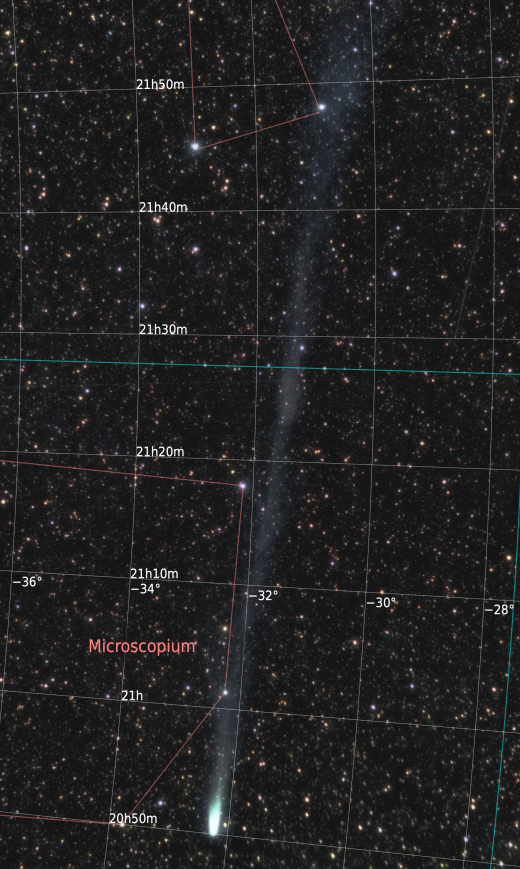
"I photographed the comet using a simple 105 mm lens on a full frame Sony A7s camera," says Gasparri. "With small binoculars we can easily see at least the first five degrees of its tail, and the rest showed up in a short exposure with the camera. The tail is astonishing!" Comet Leonard is currently gliding south through the constellation Microscopium. Its location favors southern hemisphere observers--although northerners can see it too, low in the western sky after sunset. The comet is currently about as bright as a 3rd magnitude star: light curve. The comet is heading for its closest approach to the sun (0.61 AU) on Jan. 3rd. Comet Leonard is feeling the heat, with new jets of gas and dust erupting from the comet's core. Outbursts are possible in the nights ahead, so stay tuned! Realtime Comet Leonard Photo Gallery
Free: Spaceweather.com Newsletter AURORAS AND METEORS: Two streams are better than one. Last night, a stream of debris from Comet 8P/Tuttle hit Earth's atmosphere while a stream of solar wind buffeted our planet's magnetic field. Gregory Tran photographed both over Svalbard, Norway: 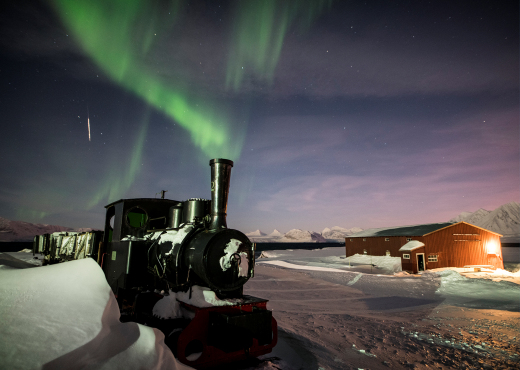
"The train seemed to be spitting auroras into the polar night," says Tran. "During the photographic exposure I was lucky to have an Ursid meteor fall from the sky." Svalbard is deep inside the Arctic Circle, and at this time of year rare polar strtatospheric clouds (PSCs) can drift over the island. "The pink glare was because of the reflection of sunlight into the PSCs," notes Tran. "The overall scenery was lit up with the almost full moon." Realtime Aurora Photo Gallery
Free: Spaceweather.com Newsletter GIFTS FROM THE EDGE OF SPACE: Christmas is coming. Are you looking for a far-out gift? Check out the Earth to Sky Store. It's filled with unique items that have flown to the edge of space onboard cosmic ray research balloons.

These unique gifts have flown above 99.7% of Earth's atmosphere, experiencing space-like blasts of cosmic rays, extreme cold, and a wild ride parachuting back to Earth after the balloon explodes. Even Amazon doesn't carry items this far out. Don't forget to enter coupon code "SPACESANTA" at checkout for a 10% Extended Black Friday discount. Far Out Gifts: Earth to Sky Store
All sales support hands-on STEM education
Realtime Space Weather Photo Gallery
Free: Spaceweather.com Newsletter Every night, a network of NASA all-sky cameras scans the skies above the United States for meteoritic fireballs. Automated software maintained by NASA's Meteoroid Environment Office calculates their orbits, velocity, penetration depth in Earth's atmosphere and many other characteristics. Daily results are presented here on Spaceweather.com. On Dec 23, 2021, the network reported 16 fireballs.
(10 sporadics, 3 Dec. Leonis Minorids, 2 Ursids, 1 Dec. Hydrid) 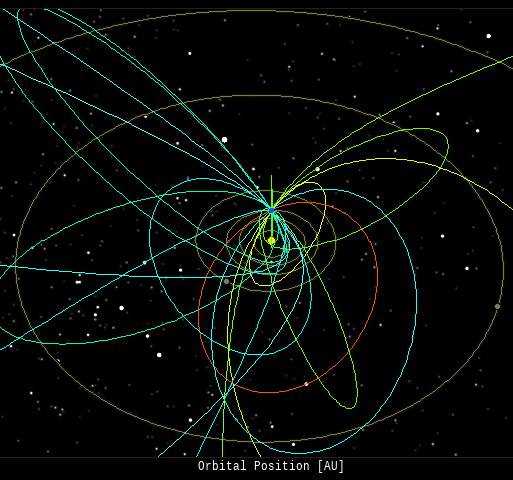 In this diagram of the inner solar system, all of the fireball orbits intersect at a single point--Earth. The orbits are color-coded by velocity, from slow (red) to fast (blue). [Larger image] [movies] Potentially Hazardous Asteroids ( PHAs) are space rocks larger than approximately 100m that can come closer to Earth than 0.05 AU. None of the known PHAs is on a collision course with our planet, although astronomers are finding new ones all the time. On December 24, 2021 there were 2245 potentially hazardous asteroids.
 | Recent & Upcoming Earth-asteroid encounters: | Asteroid | Date(UT) | Miss Distance | Velocity (km/s) | Diameter (m) | | 2021 YD | 2021-Dec-19 | 10.1 LD | 11 | 50 | | 2021 XV5 | 2021-Dec-19 | 7.9 LD | 7.1 | 28 | | 2021 XK6 | 2021-Dec-20 | 8.7 LD | 12.3 | 98 | | 2016 YY10 | 2021-Dec-21 | 11.3 LD | 9.2 | 23 | | 2017 XQ60 | 2021-Dec-21 | 13.7 LD | 15.7 | 47 | | 2021 YB | 2021-Dec-23 | 1.4 LD | 5.8 | 11 | | 2016 TR54 | 2021-Dec-24 | 16.9 LD | 15.5 | 135 | | 2018 AH | 2021-Dec-27 | 11.9 LD | 12.7 | 112 | | 2017 AE3 | 2021-Dec-29 | 9.3 LD | 19.1 | 155 | | 2014 YE15 | 2022-Jan-06 | 19.3 LD | 6.4 | 8 | | 2020 AP1 | 2022-Jan-07 | 4.6 LD | 5.7 | 4 | | 2013 YD48 | 2022-Jan-11 | 14.6 LD | 14.8 | 107 | | 2021 BA | 2022-Jan-18 | 9.8 LD | 9.1 | 22 | | 7482 | 2022-Jan-18 | 5.2 LD | 19.6 | 1732 | | 2018 PN22 | 2022-Jan-21 | 11.4 LD | 2.7 | 11 | | 2017 XC62 | 2022-Jan-24 | 18.7 LD | 4.3 | 112 | | 2021 BZ | 2022-Jan-27 | 17.6 LD | 14.6 | 39 | | 2018 CA1 | 2022-Feb-05 | 9.8 LD | 15.1 | 32 | | 2007 UY1 | 2022-Feb-08 | 13.9 LD | 6.6 | 89 | | 2020 DF | 2022-Feb-14 | 12 LD | 8.6 | 20 | | 2018 CW2 | 2022-Feb-18 | 2.2 LD | 10.8 | 25 | | 2020 CX1 | 2022-Feb-18 | 7.2 LD | 8.2 | 54 | Notes: LD means "Lunar Distance." 1 LD = 384,401 km, the distance between Earth and the Moon. 1 LD also equals 0.00256 AU. MAG is the visual magnitude of the asteroid on the date of closest approach. | | Cosmic Rays in the Atmosphere | SPACE WEATHER BALLOON DATA: Almost once a week, Spaceweather.com and the students of Earth to Sky Calculus fly space weather balloons to the stratosphere over California. These balloons are equipped with sensors that detect secondary cosmic rays, a form of radiation from space that can penetrate all the way down to Earth's surface. Our monitoring program has been underway without interruption for 7 years, resulting in a unique dataset of in situ atmospheric measurements. Latest results (Nov. 2021): Our balloons have just measured a sudden drop in atmospheric radiation. It happened during the strong geomagnetic storms of Nov. 3-4, 2021. Here are the data: 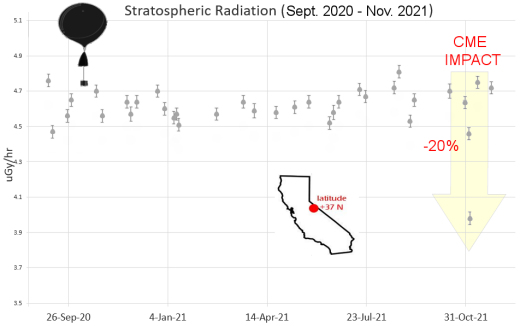
This is called a "Forbush decrease," named after American physicist Scott Forbush who studied cosmic rays in the early 20th century. It happens when a CME from the sun sweeps past Earth and literally pushes cosmic rays away from our planet. Radiation from deep space that would normally pepper Earth's upper atmosphere is briefly wiped out. We have measured Forbush decreases before. For example, here's one from Sept. 2014. The Forbush Decrease of Nov. 3-4, 2021, was the deepest in the history of our 7-year atmospheric monitoring program. Radiation levels in the stratosphere over California dropped nearly 20%, more than doubling the previous record from our dataset. En route to the stratosphere, our sensors also pass through aviation altitudes, so we can sample radiation where planes fly. This plot shows how the Forbush decrease was restricted to the stratosphere; it did not affect lower levels of the atmosphere: 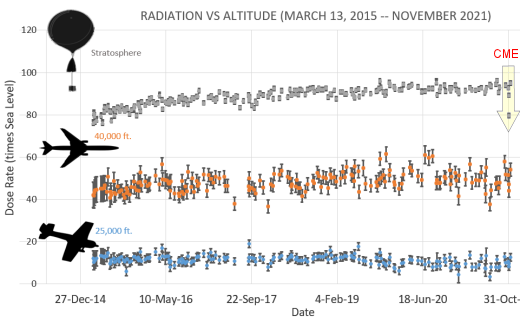
The dose rates shown above are expressed as multiples of sea level. For instance, we see that boarding a plane that flies at 25,000 feet exposes passengers to dose rates ~10x higher than sea level. At 40,000 feet, the multiplier is closer to 50x. The higher you fly, the more radiation you will absorb. .Who cares? Cosmic rays are a surprisingly "down to Earth" form of space weather. They can seed clouds, trigger lightning, and penetrate commercial airplanes. According to a study from the Harvard T.H. Chan school of public health, crews of aircraft have higher rates of cancer than the general population. The researchers listed cosmic rays, irregular sleep habits, and chemical contaminants as leading risk factors. Somewhat more controversial studies (#1, #2, #3, #4) link cosmic rays with cardiac arrhythmias and sudden cardiac death. .Technical notes: The radiation sensors onboard our helium balloons detect X-rays and gamma-rays in the energy range 10 keV to 20 MeV. These energies span the range of medical X-ray machines and airport security scanners. Data points in the first graph ("Stratospheric Radiation") correspond to the peak of the Regener-Pfotzer maximum, which lies about 67,000 feet above central California. When cosmic rays crash into Earth's atmosphere, they produce a spray of secondary particles that is most intense at the entrance to the stratosphere. Physicists Eric Regener and Georg Pfotzer discovered the maximum using balloons in the 1930s and it is what we are measuring today. | | The official U.S. government space weather bureau | | | The first place to look for information about sundogs, pillars, rainbows and related phenomena. | | | Researchers call it a "Hubble for the sun." SDO is the most advanced solar observatory ever. | | | 3D views of the sun from NASA's Solar and Terrestrial Relations Observatory | | | Realtime and archival images of the Sun from SOHO. | | | information about sunspots based on the latest NOAA/USAF Active Region Summary | | | from the NOAA Space Environment Center | | | fun to read, but should be taken with a grain of salt! Forecasts looking ahead more than a few days are often wrong. | | | from the NOAA Space Environment Center | | | the underlying science of space weather |  | Going above and beyond to provide the best homes listings in the Comox real estate market to keep you up to date and informed |  | Looking for sports betting companies not registered on GamStop? CasinoGap has presented a list of sites not on GamStop available for UK players. Check and bet online! Would you like to bet at sites not using GamStop? Look at a list of NonStopCasino sites for online betting that aren't on GamStop. Top-rated bookmakers ever! |  | One of the most popular casino games is the Book Of Dead Slot based on ancient Egyptian text, you can find all the casinos with spins at bookofdeadslotsites.com. |  | When looking for casinos to play online when the weather is bad, you can try luotettavat nettikasinot for Finnish games. If you are not from Finland you can try the Swedish page Svenska casino online to find suitable games, check out svenskacasinoonline.net. Always check your local laws before playing with real money. |  | To find reviews of new online casino sites in the UK try The Casino DB where there are hundreds of online casino reviews complete with bonuses and ratings. Alternatively, Online-Casinos.xyz is another massive directory of online casinos listing sites for the UK and Worldwide. Casinos that offer Rupees for bonuses are very generous to Indian players. Find the best online casinos in India at AllCasinos.in Looking for a new online casino? Try Casimpo the new site dedicated to making online casino simple, or check out the new Avenger Slots Casino and Ace Online Casino with over 500 online slots and casino games. | | | These links help Spaceweather.com stay online. Thank you to our supporters! | | | | | | | | |  | |  |   | ©2021 Spaceweather.com. All rights reserved. This site is penned daily by Dr. Tony Phillips. | |

